Highlights:
- As part of Tesla’s Robotaxi testing, the company is trialing fully driverless Model Y vehicles in Austin with no human driver.
- Robotaxi service expected to launch in June on an invite-only basis.
- Vehicles will be telemonitored for safety during the pilot phase.
- Tesla is still under NHTSA scrutiny over FSD safety and transparency.
In anticipation of the introduction of its robotaxi service, Tesla has started live testing of completely autonomous cars in Austin, Texas. According to Elon Musk, the cars undergoing testing are original Model Ys running a recently updated version of Tesla’s Full Self-Driving (FSD) software. These cars have been spotted driving themselves through Austin streets, suggesting that Tesla’s goals for autonomous vehicles may advance.
Robotaxi Service Coming This Month
Though some reports indicate a probable rollout as early as June 12 or June 22, the robotaxi launch is scheduled for June 2025. Musk claims that Tesla continues to take a cautious stance, strongly emphasizing dependability and safety. Musk said, “We are being super paranoid about safety,” emphasizing the company’s plan to expand the service progressively. A small fleet of 10 to 20 cars will operate in designated areas during the first phase using an invite-only concept.
Beautifully simple design. https://t.co/eA7QgzW1jh
— Elon Musk (@elonmusk) June 10, 2025
Teleoperation and Regulatory Oversight
Authorities in Austin continue to classify Tesla’s endeavor as “testing,” in contrast to competitors like Waymo, which already provides fully commercial robotaxi services in cities like Phoenix and San Francisco. Teleoperators who can intervene remotely in the event of an emergency will monitor every car participating in the test program. This strategy considers both Tesla’s distinct rollout approach and the changing legal environment on autonomous vehicles.
Market Response and Safety Scrutiny
Following the announcement of the robotaxi’s advancement and a minor relaxation of political pressure, Tesla’s shares experienced a 5% increase. However, U.S. safety officials continue to monitor Tesla’s autonomous software closely. Since there have been more than 50 fatalities connected to Autopilot or FSD use in the past, the National Highway Traffic Safety Administration (NHTSA) has asked for further information on FSD performance in challenging circumstances.

Tesla’s latest driverless vehicle trials in Austin follow a long-anticipated update to its Full Self-Driving (FSD) software, which Elon Musk previously described as a major leap toward achieving unsupervised autonomy. In earlier updates, Tesla introduced FSD Beta to select users, gradually expanding access while refining its capabilities through real-world feedback.
Although progress was incremental, the company consistently positioned each release as a critical step toward an eventual robotaxi fleet. Before the current Austin tests, Tesla’s FSD had been limited to supervised scenarios, requiring driver attention at all times. The new version, now being tested on unmodified factory vehicles without human intervention, marks the first time Tesla has publicly demonstrated a truly driverless experience, laying the groundwork for the upcoming robotaxi launch.

Tesla’s latest advancement in its Full Self-Driving (FSD) technology represents a significant leap toward its long-term vision of a fully autonomous robotaxi network. By transitioning from supervised driving to real-world, driverless testing in Austin using unmodified production vehicles, Tesla has showcased confidence in its AI-driven software and positioned itself ahead of many competitors in the autonomous vehicle space. This development underscores the company’s strategic push to validate its technology under real urban conditions, without human fallback.

While challenges such as regulatory approvals, public trust, and technical fine-tuning still remain, this testing phase could be a pivotal inflection point for Tesla’s autonomous ambitions. The move is likely to spur further innovation in the industry, prompting other automakers and tech firms to accelerate their autonomous projects. If Tesla continues this trajectory, its vision of a global robotaxi service that operates efficiently, safely, and without human input could shift from a futuristic concept to a commercial reality within the next few years.